| |
|
| |
Tomb
of Dracula
#37
October
1975
"The
vampire is coming! The
vampire is coming!"
|
|
Story
- Marv Wolfman
Art - Gene Colan
Inks - Tom Palmer
Colours - Tom Palmer
Cover - Gil Kane
|
|
|
|
|
|
| |
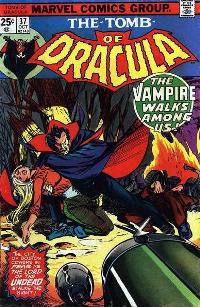 |
|
In
Boston, Dracula is racing
against time to track
down Dr Sun whilst a
struggling pulp writer
named Harold H. Harold
attempts to come up with
another story for True
Vampire Tales
magazine and tells his
publisher's secretary,
Aurora Rabinowitz, that
he will try to do an
interview with a vampire.
When Dracula attacks a
young couple riding a
motorcycle, Harold H.
Harold stumbles onto the
scene and sees Dracula's
fangs. The weakened
vampire count collapses
in front of the pulp
writer, who takes him
back to his apartment so
he can get his interview.
Uneasy about his
discovery that vampires
seemingly do exist after
all, Harold asks Aurora
to join him. In
Brazil, Brother Voodoo
magically reunites Drake
with Quincy Harker and
Rachel Van Helsing who
have just arrived at
Boston airport.
Marv
Wolfman tried to avoid an
all too harsh change in
the overall atmosphere by
choosing Boston rather
than NYC for Dracula's
arrival in America as "THE
VAMPIRE
WALKS AMONG US!"
|
|
|
|
|
|
| |
| But
even with this subtle approach he traded in what had
always felt like an authentic backdrop for the settings
and storylines. Just as Sam Spade is quintessentially a
character requiring an American setting to be authentic,
Dracula is rooted in Transylvania and Britain. Boston, in
spite of all of its olde world character, simply
could not replace that setting. As a result, the density
of the overall atmosphere - one of the main winning
points of the book - dropped almost immediately. This
coincided with another unfortunate decision by Marv
Wolfman, namely to open up the book to comedy in Tomb
of Dracula #37. Together with the already thinned
out atmosphere of the Boston storyline, this move harmed
the consistency of the book even more as it felt
awkwardly out of place even in the way it was brought
into the plot: Quite unlike his usual storytelling and
characterization technique, Wolfman is almost
unrecognisably transparent and simplistic as he
introduces would-be horror writer Harold H. Harold and
his publisher's secretary Aurora Rabinowitz. As the names
suggest beyond even the faintest shadow of a doubt,
Harold is intended as comic relief, and Aurora is there
to feed the naive punchlines (Witz,
incidentally, meaning "joke" in German).
It
is a matter of both taste and opinion whether or not Tomb
of Dracula needed the Abbott and Costello type of
fly-in-your-face comic relief that Harold and Aurora
were to provide, but even those who felt the answer was
yes found that both wore out pretty fast. Wolfman had
injected subtle doses of wry humour ever since he took
over the scripting, mostly uttered by Blade and with
ironic undertones, but it never interrupted the eerie
tone of the plot - this was, after all, a story about
vampires. The characters of Harold H. Harold
and Aurora Rabinowitz, however, were irritating from the
moment they were introduced.
|
| |
|
| |
Tomb
of Dracula
#38
November
1975
"Blood-rush!"
|
|
Story
- Marv Wolfman
Art - Gene Colan
Inks - Tom Palmer
Colours - Tom Palmer
Cover -
|
|
|
|
|
| |
|
| |
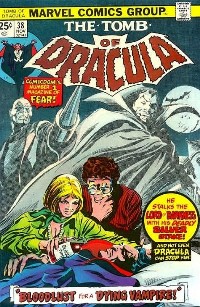 |
|
Would-be
horror writer Harold H.
Harold breaks into a
medical school and steals
bottles from the blood
bank so he and Aurora
Rabinowitz can revive
Dracula. At the same
time, the gang of vampire
hunters are lured into Dr
Sun's headquarters who
tells them that they
will be spared if they
decide to side with him.
Harker unleashes one of
his wheelchair's weapons,
a barrage of wooden darts
designed to explode once
inside a vampire. Dr Sun
is hit, and even though
he survives the
explosions, the part of
the system sustaining his
brain - and which has
also been draining
Dracula's powers - is
destroyed, thus ending
his grasp on the vampire
count. Back
at Harold's apartment,
Dracula is revived by the
blood administered to
him, and consents to the
interview Harold asks him
for. However, this is
interrupted by the
arrival of Dr Sun's
servant Juno who sports a
silver spike instead of a
left hand and forces the
still weakened vampire to
follow him to Dr Sun's
headquarters, where he is
told by Sun that he shall
never leave again.
|
|
|
|
|
|
| |
| Tomb
of Dracula #38 sets up a rematch between Dracula and
Dr Sun after their first encounter ended in Tomb of
Dracula #21. One and a half years had passed since
in real time, and the series had been through a number of
changes. Maybe it was the fact that Dracula and Dr Sun
had a face-off before which made the sum of all of these
small changes so evident in one issue: the general
atmosphere had changed - not completely, but
intermittently. Despite some single issue plots which
came close to the lesser examples of "B" horror
movies, Tomb of Dracula had never felt cheesy.
Now, however, some of the plot of Tomb of
Dracula #38 dropped to downright ludicrous - it
really felt more like an issue of Mad Magazine
doing a spoof of the series, as the following piece of
dialogue shows:
HAROLD:
Er, Dracula, sir? Could I speak with you, just for a
moment or so? You see, I promised the publisher of
this magazine I work for, to interview a real
vampire. And you may be the only one who can save my
job.
DRACULA: What care have I of your problems, human? I
gave you thanks, and that is more than you should
expect. Be thankful I do not slay you for blood. For
I may have need of you shortly, and therefore you
will be spared.
HAROLD: Gosh, thanks, Dracula-- sir! Really, thanks!
In
the established tradition of Tomb of Dracula,
Harold H. Harold and the story woven around him was just
plain silly - a character better suited for the whacky
world of Marvel's Howard the Duck (where, sure enough, he
did appear). Tomb of Dracula #38 was a turning
point as the comedy element introduced by Marv Wolfman
backfired completely and basically killed an overall
atmosphere which was already thinning out a bit and was
in need, if anything, of reinforcement. Instead, Wolfman
placed a character at center stage who was nothing but a
completely neurotic fool. A few of his lines were funny,
most of them weren't, but they all resulted in the same:
it was getting increasingly hard to take events seriously
when you were constantly confronted with oneliners which
could have come straight from a Woody Allen spoof on
vampire movies. Or was Wolfman thinking about Polanski's Fearless
Vampirekillers in the back of his mind? Whatever it
was, it didn't work in the context of Tomb of Dracula
- an opinion shared by Gene Colan even though he had
a soft spot for Harold:
"Marv
also put in Harold H. Harold - that was a good
character, but he would dominate the Dracula book to
the point where it wasn't Dracula! And although I
enjoyed drawing him - it was a comical break from the
seriousness of it - and Dracula came in at the end or
the middle a little bit, you didn't see much of
Dracula." (2001 interview with
Gene Colan, published in Comic Book Artist
#13)
|
| |
|
| |
Tomb
of Dracula
#39
December
1975
"The
death of Dracula!"
|
|
Story
- Marv Wolfman
Art - Gene Colan
Inks - Tom Palmer
Colours - Tom Palmer
Cover -
|
|
|
|
|
|
| |
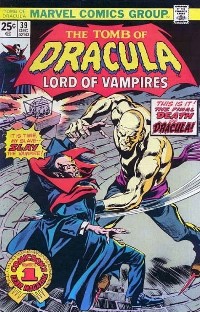 |
|
At Dr
Sun's headquarters,
Dracula and Juno
clash. None of them
is gaining the upper hand
until Harold and Aurora
burst onto the scene,
having finally found
Sun's headquarters. This
moment of distraction is
all Juno needs as he
strikes Dracula from
behind with the silver
stake, killing the
vampire lord. As Dracula
is dying he apologizes to
Quincy Harker, telling
his longtime foe that
Harker should have been
the one to slay him. Dr
Sun wants to ensure that
he is never revived and
burns Dracula's remains
to ashes which are then
put into an urn - the
final triumph of Dr Sun,
who lets the vampire
hunters escape to an army
base as he has plans to
use them for his scheme
of world domination. The
growing and, for some,
rather nagging feeling
that the series was
changing was made
visually apparent when Tomb
of Dracula #39 hit
the newsagents stands.
The logo, hinting at the
shadow of a bat, was
changed into the shape of
an outstretched cloak,
and the small figure of
Dracula in the upper left
hand corner was revised.
The comic also gained the
sub-title "Lord of
Vampires". To round
it off, Marvel placed a
rosette-shaped blur on
the cover proclaiming
this to be
"comicdom's number 1
fear magazine".
|
|
|
|
|
|
| |
| This
was indeed the case at the time, but it could also be
seen as an attempt by Marvel to add a "buying
point" not just to new but also to seasoned readers
who were feeling unhappy about the latest developments.
To them, the title of issue 39 - The death of Dracula
- sounded sadly fitting, as this was, in a way, the end
of the Dracula series they had known and come to
appreciate. |
| |
|
| |
TOMB OF DRACULA #
40 - 70
January 1976 - August 1979
|
| |
|
| |
| Even though
Marv Wolfman and Gene Colan continued as a team on the
remaining 31 issues of Tomb of Dracula,
the series had taken on an entirely new direction. |
| |
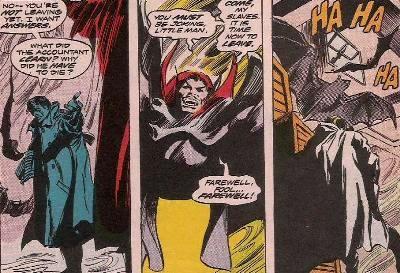
Earlier on, Dracula mocks any
attempts (in this case by Hannibal King in Tomb
of Dracula #25) asking him to reveal his
knowledge. In later issues, Dracula would accept
such demands to almost no end.
|
|
It wasn't a case of Wolfman's
storytelling becoming uninteresting - for most of
the time, there was always something there to
keep it all from falling apart completely. However,
Pandora had slipped Wolfman a few boxes which he
had opened and which went on to plague the series
to no end. Harold H. Harold was one such box,
another one was overdoing Dracula's weakness
induced by Dr Sun, because it lead to Dracula
becoming one of the cast of actors rather than
being the central and paramount threat to
everyone.
Thus
Dracula is brought back to life by Harker and the
gang of vampire hunters in Tomb of Dracula
#41 as an ally to defeat Dr Sun (which he does),
and the mould is cast, for in the final panel of
that issue it is Blade's turn to do his version
of the "you owe me a favour" game when
he virtually commands Dracula to help him track
down the vampire who killed his mother.
Marv
Wolfman had unleashed the taming of the lord of
vampires...
|
|
| |
| The
(undisputed) need to take the book's general plot into
new directions had thus turned from a simple option for
improvement to a looming necessity for saving the title
in an akwardly short span of time, and the now introduced
American setting didn't exactly make things easier. |
| |
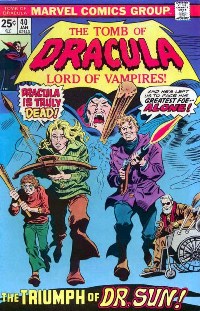 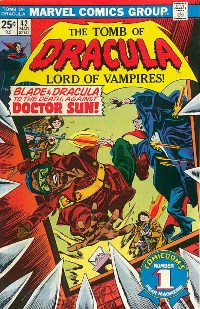
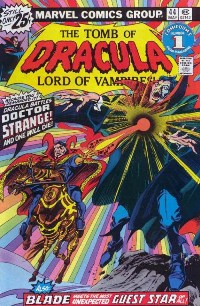
|
|
The vampire count was
propelled further into the Marvel Universe
following the appearance of Brother Voodoo in Tomb
of Dracula #34 (where Brother Voodoo only
meets Frank Drake, not Dracula himself) by direct
encounters of the vampire count with Doctor
Strange in Tomb of Dracula #44 and the
Silver Surfer in Tomb of Dracula #50. The guest
appearances of Doctor Strange and the Silver
Surfer were entertaining but also widened the
growing number of gaps in the book's consistency.
For one thing, the previous portrayal of
Dracula's weakness made it very difficult to
believe that neither a sorcerer such as Doctor
Strange nor a cosmic being such as the Silver
Surfer would do anything but destroy the count
within minutes.
The
storyline of Tomb of Dracula #44 was
carried over to Doctor Strange #14 and
finally completed much later in Doctor
Strange #58-62, when the sorcerer supreme
did just what readers of Tomb of Dracula #44
thought would happen, namely put an end to all
vampires - by casting a magic spell called the
"Montesi formula".
In
essence, the forays of Dracula into the Marvel
Universe didn't help the book at all. Tomb of
Dracula had always been at its peak in terms
of plot and storytelling when conveying the
uniqueness of Dracula - which Wolfman himself had
always clearly prefered.
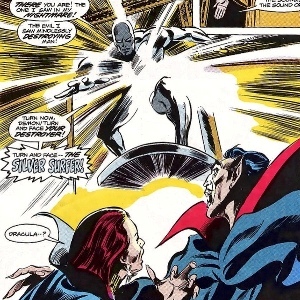
The Silver Surfer makes his
entrance in Tomb of Dracula #50 - "turn
now, and face your destroyer!"
|
|
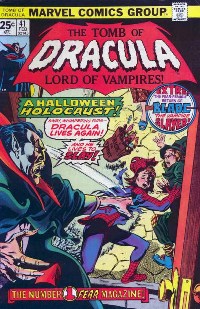 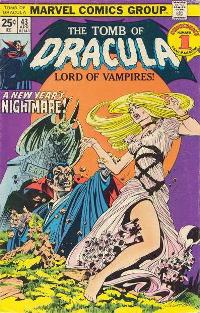
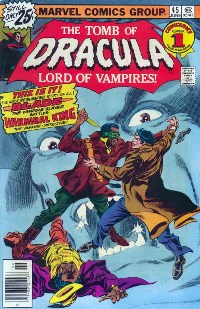
|
|
| |
| In the end,
the somewhat forced opening of Tomb of Dracula would
reveal itself as another substantial weakening of the
overall plot and therefore, ultimately, an important part
in the faltering of the title. |
| |
|
| |
| Perhaps an
almost logical move was to introduce Anton Lupeski and
his Boston based satanic sect - clearly modelled on
real-life satanist Anton LaVey. |
| |
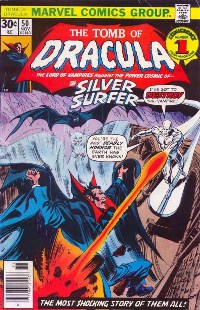 |
|
But even though this kept the
story moving and produced a number of new
subplots and characters, the wedding
of Dracula to one of the sect's female members
and ultimately the birth of Dracula's son really only
diluted things even further as additional
characters made the round, from Robin Hood to
Satan himself, before going back to Harold H.
Harold. Marv Wolfman had gotten
himself and the book into a very tight spot, and
it never again matched up to his first 30 issues
of Tomb of Dracula, simply because it
all got so entangled and so far removed from the
essence of a vampire story. Steadily, the title
started to falter at the newsagents. As of Tomb
of Dracula #61 (November 1977), the comic
went back to bi-monthly publication, and when Tomb
of Dracula #68 (February 1979) was published
three months after its preceding issue, all was
clear.
|
|
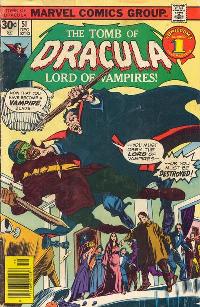 |
|
| |
|
| |
| Tomb of
Dracula #69 followed the bi-monthly publication
sequence again but contained the announcement that the
series would be cancelled. |
| |
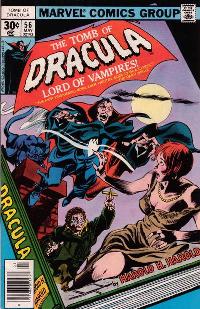 |
|
Just to what extent Tomb
of Dracula had lost favours with a
readership which previously had been extremely
loyal could be seen from Wolfman's statement that
despite plans to wrap up the series over another
three books (which would have been Tomb of
Dracula # 72) the end would now be
compressed into one, double-size issue, making
issue #70 the final one. The final
issue thus appeared on the newsagents stands in
August 1979, four months after the penultimate
issue #69 had been published. But at least, the
series bowed out in style, with Wolfman finding
back to the roots of the success of Tomb of
Dracula with an intensive and atmospheric
storyline which ends when Harker puts
an end to Dracula by blowing himself up and
burying the count underneath the rubble of Castle
Dracula.
|
|
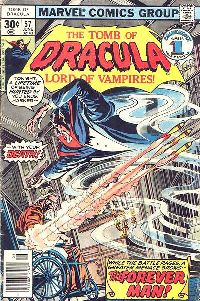 |
|
| |
| Real-life
suicide-bombers were still few and far between in those
days, so this ending had a heroic undertone it would not
have today. |
| |
|
| |
| Marvel's
reasoning for the downfall of Tomb of Dracula was
that the material was contained in the wrong kind of
packaging. |
| |
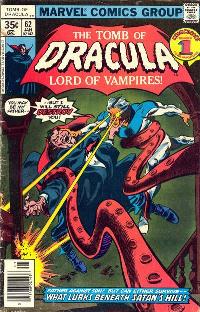 |
|
Instead of a code-approved
colour comic, the House of Ideas felt that a
black and white magazine-format publication
(without code-approval and hence marketed as
being for "mature readers") would prove
right. Readers who had followed the
colour comic book, of course, knew better, and
were hardly surprised by the fact that the
magazine-format Tomb of Dracula - which
was launched in October 1979 and published
bi-monthly - only lasted for six issues, bowing
out in August 1980.
It
contained stories by Wolfman and Colan which were
fairly good (but which essentially made readers
yearn for the "old Tomb of Dracula"),
and stories by others which went from mediocre to
downright awful.
|
|
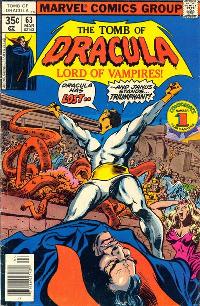 |
|
| |
| In the end,
Marvel had to acknowledge that the days for Tomb of
Dracula were over. Exitus. |
| |
|
| |
| However,
just like the vampire count himself, Tomb of Dracula
rose anew in 2008 - almost 30 years after its
cancellation - when Marvel released the first 31 issues
of Tomb of Dracula in its high-end production
value Omnibus edition series - the first Marvel
horror title to receive such a publication platform. |
| |
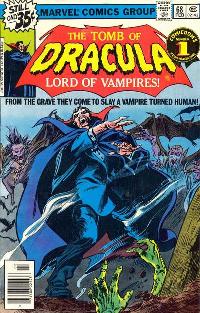 |
|
This would be followed by two
further Omnibus volumes, ultimately collecting
Marvels complete Tomb Of Dracula
material (both from the comics as well as the
magazines). Whilst this is an indication of its
status as a classic comic book title (and also
its continuing selling potential), the true
importance of Tomb of Dracula lies
elsewhere: in the way it shaped and influenced
comic book history. First off, Tomb
of Dracula was the first continuing comic
book title which featured a horror genre
character both as its leading role and,
consequently, as part of its title (from a purely
chronological point of view, Marvel's character
Werewolf by Night preceded Tomb of Dracula #1
by two months, but only got his own title in
September 1972 after appearing in Marvel
Spotlight for three issues).
|
|
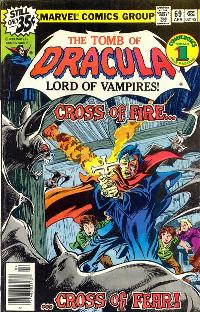 |
|
| |
| Secondly,
the launching of Tomb of Dracula took place in
the context of Marvel's outing into the world of ghouls,
monsters and vampires, which had been kicked off in
1970/71 but really only gathered speed and became one of
the most innovative moves in the company's history when Tomb
of Dracula appeared on the scene. |
| |
| Ultimately covering the genre
from wall to wall, Marvel's innovative approach
was to infuse it with the underlying principles
of the superhero comic book. The "superhero
from the crypt" is one of Marvel's milestone
contributions not just to the Bronze Age period
of the 1970s, but to comic book history as a
whole, and the basics of this concept were all
tried out and then refined foremost in Tomb
of Dracula. And finally, the new momentum
and 21st century revival of Marvel Comics which
was triggered by the series of big budget movie
adaptations based on the House of Ideas'
characters was not started by one of the now
newly popular superheroes, but rather by a
character from Tomb of Dracula as Blade
broke the Hollywood ice for Marvel in 1998.
Tomb
of Dracula gained this key importance both
for Marvel as a company as well as for the comic
book history of the 1970s by being both a
creative masterpiece and a revolutionary concept
- it simply broke new grounds.
|
|
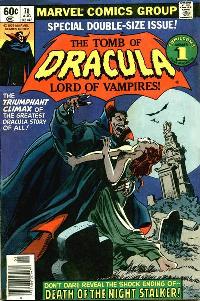 |
|
| |
| Together
with the intense and atmospheric pencilling of Gene Colan
and inking by Tom Palmer, Marv Wolfman's non-conformist
comic book approach to Bram Stoker's classic genre
character produced yet another classic: The Tomb of
Dracula. As is the case with classics, the title has
aged very well, and the appeal especially of the first 35
issues is, by comic book standards at least, seemingly
timeless as both seasoned readers and newcomers pick up
Marvel's classic horror material and once again thrill to
the terrors which await them in the Tomb of Dracula. |
| |
|
| |

